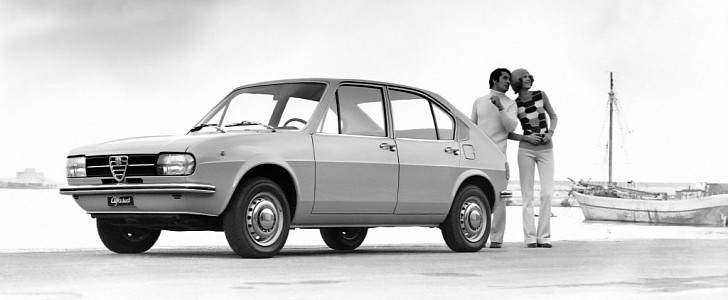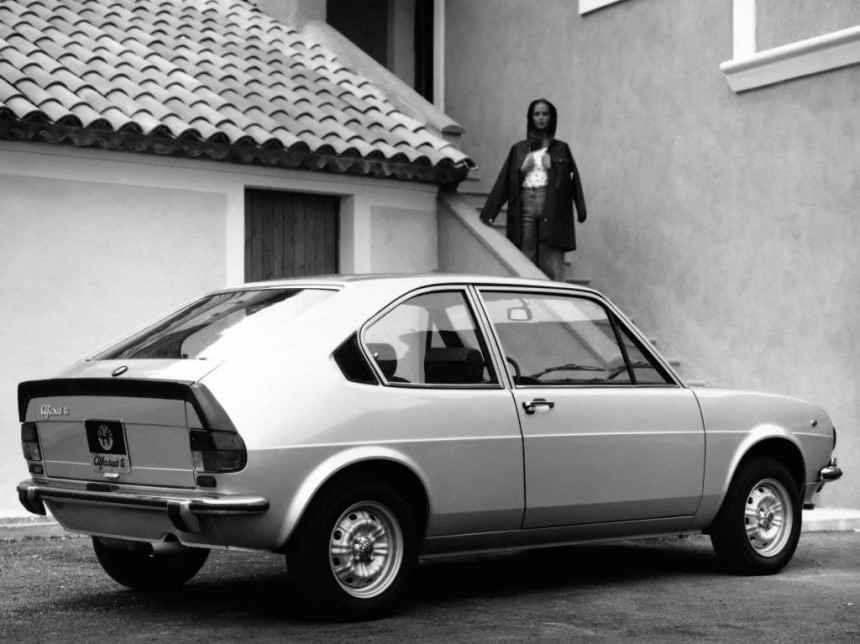Alfa Romeo started experimenting with front-wheel drive in 1952. Had it entered series production in a timely fashion, Project 13-61 would have preceded the Mini. The Italian marque developed yet another front-wheel-drive automobile in the guise of the Tipo 103, but once again, the bean counters couldn’t make a case for it due to financial difficulties.
Due to rising demand for sensibly-priced cars in the late 1960s, the Biscione manufacturer decided that it was its high time for a front-wheel-drive econobox.
Chief executive officer Giuseppe Luraghi approached the Italian government for much-needed funding during a time when young workers looking for better-paying jobs moved north. Obviously enough, the government was genuinely interested in slowing down this exodus, which is why the loan that made the Alfasud possible came with one string attached.
More specifically, Alfa Romeo had to manufacture the new vehicle in the economically-deprived Italian south. And just like that, the Italian automaker agreed to erect a brand-new factory in Pomigliano d'Arco.
No fewer than 360 billion lire were loaned, and part of that money was used to poach Rudolf Hruska from Turin-based Fiat. Born in Vienna, the Austrian designer and engineer that deserves to be called Mr. Alfasud had previously worked on the Volkswagen Beetle, Porsche Tiger VK 4501 tank, Alfa Romeo Giulietta, and the Fiat 128 that cannibalized with the Alfasud.
Even for a guy this talented, the timing was extremely tight because the foundation stone of the Pomigliano facility was laid in 1968, and the car had to be ready in 1971. Happily, for him, Hruska was joined by a crack team of experts that included project leader and engineer Domenico Chirico, design legend Giorgetto Giugiaro, and Italdesign wingman Aldo Mantovani.
The boxer engine of the Alfasud was fired up on the bench stand for the first time in July 1968. That November, the very first prototype was tested at Circuito di Balocco in the Vercelli province of the Piedmont region.
Publicly introduced in November 1971 at the Turin Motor Show, the Alfasud achieved excellent handling for that era by lowering the center of gravity with the help of front-wheel drive and the horizontally-opposed engine that was originally rated at 63 metric ponies. For a car that weighs 830 kilograms (1,830 pounds), that’s pretty good by ‘70s standards.
The Alfasud was offered in a multitude of body styles, including two- and four-door sedans, three- and five-door hatchbacks, a three-door coupe dubbed Sprint, and a three-door wagon marketed as the Giardinetta.
July 1977 is when the Alfasud became a sporty car with the introduction of a larger engine, a 1.3-liter boxer that cranked out 76 PS. Later on, Alfa Romeo upgraded the four-cylinder powerplant to 1.4 and 1.5 liters.
From the innovative packaging to the spirited handling and pleasurable styling, the Alfasud had a lot going for it. Motoring publications couldn’t stop waxing lyrical, praising the aforementioned traits like there was no tomorrow. But tomorrow eventually came, and the Alfasud proved to be a rotter that would make the Lancia Beta smile with a face-wide grin.
Alfa Romeo used low-quality steel, and the rustproofing left much to be desired as well. Corrosion would build up within a matter of months, ruining the Alfasud’s reputation forever. We also have to remember that build quality wasn’t exactly great. Worse still, the Pomigliano d'Arco workforce had this bad habit of striking every Thursday or so. It’s estimated the production line ground to a halt a simply staggering 700 times until 1989.
Awarded “Car of the Decade” by CAR Magazine in 1980, this fellow can’t be considered a commercial flop because Alfa Romeo sold more than one million units. Replaced by the Arna and 33, the Alfasud is revered to this day because it dared to defy the twin-cam RWD formula we often associate with the Italian automaker’s greatest hits from 1954 through 1994.
Chief executive officer Giuseppe Luraghi approached the Italian government for much-needed funding during a time when young workers looking for better-paying jobs moved north. Obviously enough, the government was genuinely interested in slowing down this exodus, which is why the loan that made the Alfasud possible came with one string attached.
More specifically, Alfa Romeo had to manufacture the new vehicle in the economically-deprived Italian south. And just like that, the Italian automaker agreed to erect a brand-new factory in Pomigliano d'Arco.
No fewer than 360 billion lire were loaned, and part of that money was used to poach Rudolf Hruska from Turin-based Fiat. Born in Vienna, the Austrian designer and engineer that deserves to be called Mr. Alfasud had previously worked on the Volkswagen Beetle, Porsche Tiger VK 4501 tank, Alfa Romeo Giulietta, and the Fiat 128 that cannibalized with the Alfasud.
Even for a guy this talented, the timing was extremely tight because the foundation stone of the Pomigliano facility was laid in 1968, and the car had to be ready in 1971. Happily, for him, Hruska was joined by a crack team of experts that included project leader and engineer Domenico Chirico, design legend Giorgetto Giugiaro, and Italdesign wingman Aldo Mantovani.
The boxer engine of the Alfasud was fired up on the bench stand for the first time in July 1968. That November, the very first prototype was tested at Circuito di Balocco in the Vercelli province of the Piedmont region.
The Alfasud was offered in a multitude of body styles, including two- and four-door sedans, three- and five-door hatchbacks, a three-door coupe dubbed Sprint, and a three-door wagon marketed as the Giardinetta.
July 1977 is when the Alfasud became a sporty car with the introduction of a larger engine, a 1.3-liter boxer that cranked out 76 PS. Later on, Alfa Romeo upgraded the four-cylinder powerplant to 1.4 and 1.5 liters.
From the innovative packaging to the spirited handling and pleasurable styling, the Alfasud had a lot going for it. Motoring publications couldn’t stop waxing lyrical, praising the aforementioned traits like there was no tomorrow. But tomorrow eventually came, and the Alfasud proved to be a rotter that would make the Lancia Beta smile with a face-wide grin.
Alfa Romeo used low-quality steel, and the rustproofing left much to be desired as well. Corrosion would build up within a matter of months, ruining the Alfasud’s reputation forever. We also have to remember that build quality wasn’t exactly great. Worse still, the Pomigliano d'Arco workforce had this bad habit of striking every Thursday or so. It’s estimated the production line ground to a halt a simply staggering 700 times until 1989.
Awarded “Car of the Decade” by CAR Magazine in 1980, this fellow can’t be considered a commercial flop because Alfa Romeo sold more than one million units. Replaced by the Arna and 33, the Alfasud is revered to this day because it dared to defy the twin-cam RWD formula we often associate with the Italian automaker’s greatest hits from 1954 through 1994.




























